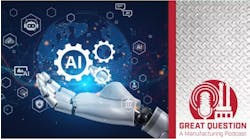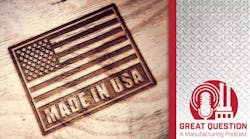A few years back, I spent a sleepless night worrying about robots. We’d just bought our first six-axis fully
robotic trimmers, and the next day we were going to learn if I’d made a smart investment in the future of our company, or just wasted a ton of money and put that future at risk.
Ray Products has been manufacturing plastics with thermoforming for close to 70 years. When my grandfather and father were CEOs, a plastic part would come out of the mold, and then be trimmed by a team of skilled employees using hand tools. After I took the reins, my first big investment was in robots that would do the job faster and more accurately than those people.
Now, you think you know where this story is going. You’ve heard it before: robots do the job better and faster, workers are out of a job.
And that perspective isn’t unfounded. A 2017 report estimated that one-third of the workforce in the United States would be replaced by machines by 2030. Another study from the University of Oxford painted an even direr picture: up to 47% of current jobs are at risk due to automation.
And it’s not just manufacturing jobs that are feeling the crunch. Tesla, Lyft and several other companies are working toward automated ridesharing services, taking the driver out of the equation. Radiologists are even being threatened by software that can do the same job more than 100x faster.
I don’t have much experience with the field of radiology, but I do have experience with what automation can do to the workforce of a manufacturing plant: it can increase it.
Back to my robot story for a moment. After my sleepless night, I went into work with a knot in my stomach. I watched as our small, expensive army of robotic workers were activated and made their first cuts. It didn’t take long before I realized we’d made the right call. The robots were faster and more accurate than even our most skilled workers. And I could feel good for another reason: no one lost their job to a robot.
Every worker in a manufacturing facility plays a critical role in the success of that facility. Our employees who were performing manual trimming were great workers, not just great trimmers. In my experience, if a worker’s great at one skill, they can be great at other skills.
So, when we decided our future was in more automated processes, we also committed to doing everything we could to make sure we kept the workers whose tasks were being replaced. Some easily moved into similar tasks with minimal training, while others went through more significant transition.
In every case, they had the ability to use the core skills that had made them great trimmers—accuracy, efficiency, precision and the ability to solve problems—in another role. And that benefited our company tremendously.
First, and most obviously, it let us hold on to key parts of our workforce during a transition in operations. Second, it showed our entire team that they didn’t have to be afraid of automation. Today, when we embrace a new automation initiative, we get support from the ground up because our workforce knows that automation isn’t a threat to their jobs.
Finally, automation meant growth. We were one of the earliest thermoforming manufacturers to embrace robotic trimming, and word spread fast. In an industry that often creates parts for high-end medical, electronic and transportation equipment, precision and efficiency are valuable commodities. Our robots helped us deliver more of both.
Today, thanks in no small part to the growth driven by our early adoption of automation and technology, our workforce is about 20% larger than it was the day our first robots went online. That’s despite implementing a range of automation and efficiency initiatives across our operations. Our automation has made us far more efficient, and brought us significant growth that demands a larger workforce.
My advice to leaders concerned about automation prompting job loss, is to:
- Stop seeing automation and jobs as opposing forces
- Understand the true value of your workforce
- Be willing to invest in training that lets you keep that value, and invest in automation that drives growth alongside efficiency
Hopefully, we can build a future where automation drives growth on Wall Street, and on Main Street.
Brian Ray is CEO of Ray Products.


